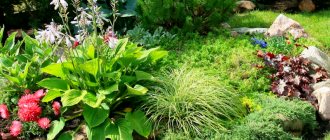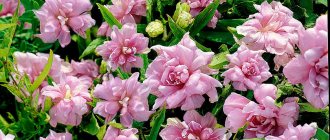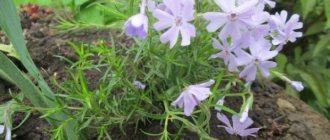Hosta (aka funkia) is a popular perennial that even a beginner can grow. But for this you need to know some rules for caring for this plant.
The main advantage of the hosta is its large, elegant leaves, which amaze with the variety of colors and textures. And no less attractive are the racemose inflorescences of small funnel-shaped flowers. However, these plants only look spectacular when grown under certain conditions.
In some hosta varieties, the flowers are not very attractive, so the emerging peduncles are immediately cut off so that they do not overshadow the beauty of the leaves.
Hostas love moisture and shade, but at the same time easily tolerate drought. In the wild, they grow mainly along the banks of rivers and streams, on mountain slopes and forest edges. This must be taken into account when planting hosta in a summer cottage.
In Japan, hosta is considered a sacred plant. The petioles of its leaves are used as a delicacy.
Hosta - growing in the garden. When and where to grow
Hosta begins to grow later than other plants. Therefore, it can be safely planted in the spring. In the fall, if you plant it not too late, it also takes root well. But even in the summer, if you replant it together with a clod of earth, it also does not suffer from replanting. Still, the best time to plant a flower is spring, when the threat of frost has passed. April-early May is the best time.
When choosing a place for planting, you must take into account that not all varieties prefer shaded and cool places. The lighter the leaves are, the more sun it needs. When choosing a place for planting, take into account some of the features of its cultivation.
- Varieties with a dark green or blue color should be planted only in the shade.
- Light varieties can be planted in partial shade, where the sun illuminates the area before 11 a.m. or after 4 p.m. It is allowed to place bushes in sunny places, but with a lacy shadow from trees or shrubs at midday.
Compatibility with other plants
Since this shrub is very friendly, planting hosta with the following plants is possible:
- fern;
- heuchera;
- anemone;
- Brunner;
- geranium;
- Horny goat weed;
- lungwort;
- astilbe;
- digitalis;
- primrose.
And, of course, it harmonizes with various types of coniferous plants, outdoor tradescantia, peonies and garden grasses.
How to plant purchased hosta roots
When choosing seedlings, pay attention to its root system. They must be at least 10 cm long, optimally 10-15 cm. The roots must be juicy, elastic, that is, alive. The more buds the seedlings have, the better. A young plant with 3-4 buds is the best option.
What else needs to be considered when purchasing seedlings? When choosing varieties when purchasing, some gardeners give preference to several varieties with different leaf colors. And they don’t think at all that different varieties have different sizes of adult bushes. After all, there are giant hosts, and there are also dwarfs. And if this is not taken into account when planting, then in 2-3 years the giants will most likely strangle the babies.
Therefore, before buying seedlings, carefully study the characteristics of the varieties. Especially consider the size of adult bushes.
Planting and growing hosta in open ground
It is better to choose the time for planting seedlings in the evening, optimally after 18 hours, when the sun is no longer scorching. At this time, it is easier for a young seedling to endure the stress of transplantation.
For planting, dig a fairly wide and deep hole. Its size depends on the size of the adult plant at the age of 6 years.
- For giant and large hostas, the pit should be 80-150 cm wide and up to 0.5 m deep.
- The dimensions of the planting pit for medium and small bushes are 30-60 cm and up to 25-35 cm deep.
- For miniature and dwarf varieties, the width of the hole should be 15-20 cm and depth 10-15 cm.
Compost or rotted manure is added to the bottom of the planting hole, thereby significantly improving the nutritional value of the soil, and hosts are very fond of organic matter. It will be good if you add peat. This will give the soil breathability and lushness. Add a handful of wood ash to the soil mixture - this will also not be superfluous. If the area is dry, add more perlite or perlite sand; it absorbs moisture well and then gradually releases it to the roots.
Also, add a tablespoon of complex mineral flower fertilizer to each hole, so you don’t have to bother with fertilizing later. Such fertilizers dissolve in the soil gradually, up to 6 months. In this case, overfeeding does not occur. The hosta will absorb as much fertilizer as it needs.
Fill the planting hole to 2/3 of its volume with nutritious soil mixture and water well. We form a mound at the bottom of the hole. We lower the seedling, straightening the roots down the mound. Fill the hole with soil and lightly compact it with your hands. And water again.
It is better to mulch the soil around the planted seedling to maintain soil moisture and prevent the appearance of an earthen crust. For mulch, you can use peat in a layer of at least 2 cm.
How to care for hosta in spring after winter
Hosta wakes up in the spring much later than other plants. And some gardeners even think that it has already died. Other flowers, for example, the same peonies, have already released their buds. However, there is no need to be upset. If you look closely, you can see how small buds emerge from the ground - beaks, these are sprouts that have hatched. This means that it’s time for the first feeding.
To do this, scatter 1 tbsp around the bush. l. complex slow-release flower fertilizer. And from organic matter it is better to scatter chicken manure in granules, it will also be absorbed slowly. There is no need to dilute chicken manure with water. After this, all that remains is to loosen the soil, water and mulch.
If you were unable to buy a complex slow-release fertilizer, then you will have to feed the hosta several times a season.
- The first time is in the spring after winter, as soon as the buds hatch;
- the second time - during flowering;
- and the last time after the plant has flowered.
Alternate organic fertilizers with mineral ones. Before and after flowering, any complex mineral fertilizer will do. After flowering and in the fall, you can put ready-made compost from fallen leaves or humus under the bush. Organic matter will perfectly serve as mulch.
Even an unpretentious perennial requires care.
Caring for hostas requires that you control two important aspects: high humus content and soil moisture.
For the first 4 years after planting, fertilizers may not be applied. It is enough to mulch the soil around it once a year. It is also permissible to use liquid mineral fertilizers once every 14 days in the first half of summer (for poor soil with a low content of nutrients).
The soil around the bush should be constantly moist. Water it in the morning, avoid getting water on the leaves. Make sure that the flower is not affected by diseases and pests. If necessary, use special preparations or remove the diseased plant from the area.
If you notice that the edges of the leaves are darkening, increase watering. Moderate soil moisture is the basis for caring for these hostas.
The peculiarity of the plant is that after flowering the rosette loses its shape. To prevent this from happening, some gardeners cut off flower stalks at the formation stage. 5 years after planting, cuttings can be separated from the root and transplanted to another location.
September is a time of preparation for rest. If the perennial still has flower stalks, remove them. During this period, you can start dividing the bush.
Growing, caring for and feeding hosts
The main care of the plant is regular watering. Watering is best done after sunset, but not too late. It is necessary that the leaves have time to dry by night. Otherwise, the hosta will become a habitat for slugs.
She loves watering by leaves. However, you should know that blue varieties cannot be watered from above. The leaves of these varieties are covered on top with a thin layer of wax, which is washed off when watered from above. This should not be watered because the flower remains unprotected from external influences, and in addition, the decorative effect of the bush is lost. It is the wax that gives the leaves their blue color.
Promptly remove leaves that have lost their decorative properties. And also do not forget to remove the arrows of faded flowers. They spoil the appearance, and the plant itself spends a lot of effort on ripening the seeds. If you don’t like the flowering of a certain variety, don’t be afraid and feel free to cut off the young flower stalks. In this case, the bush will look better and will not fall apart. Trimmed leaves from healthy specimens can be composted and treated with antifungal agents in the spring.
Popular varieties and types of hosta with photos
Due to the fact that the hosta plant crosses well, it has been possible to develop a large number of different varieties and species of this frost-resistant flower, which are in great demand both among professional landscape designers and amateur gardeners.
White feathers
This type of hosta is one of the fastest growing in nature. It is highly resistant to negative factors and has a spreading base.
The main value of the funkia is its wavy leaves, painted in a creamy white color, which, as the plant grows, are diluted with bright green veins. Maximum decorativeness will be achieved 5 years after planting. The plant blooms from July to August.
Podorozhnovaya
Hosta plantain is an ornamental shrub that prefers places where there is high humidity. Therefore, it is mainly used for landscaping areas near artificial reservoirs and swimming pools. It is distinguished by a powerful crown, shiny green leaves that have distinct veins. This type of hosta is also valued for its long flowers, which are not bell-shaped, but tubular in shape.
Blue Angel
Blue Angel is a dome-shaped shrub that has lush blue-green foliage. This is one of the most striking representatives of the host chameleons, as the color changes to dark green towards the end of the season. The leaves of the plant are large, have curved ends, but the surface is corrugated and has white veins.
Mix
This is not a separate variety of shrub, but a group of varieties that have foliage of different colors. The shades combine perfectly with each other, creating a harmonious composition that will become a real decoration of any garden.
Atlantis
This is a hybrid variety of shrub that has large and spreading leaves that can reach 20 cm in width. Hosta foliage has two-color leaves - the core is colored rich green, but the edges are framed by a green-yellow border. The unpretentious plant blooms from July to August with lavender-colored flowers.
Antiochus
A perennial of this species has an oval-shaped leaf blade, which has dense flesh and a chartreuse border. Foliage color is medium to dark green. The older the plant, the border changes color from creamy yellow to grayish green. It blooms with small lavender flowers.
August Moon
This hosta species is one of the first in the yellow-leaved category. The foliage has a rounded heart-shaped shape, which in early spring has a greenish-yellow tint, but turns yellow in summer. The flowers are bell-shaped and lavender in color.
Albomarginata
Developed in Japan, hosta has dense foliage that forms a hemispherical bush. One of the most highly intensive plants in terms of growth, the shrub can grow 8 cm in height in a year. The emerald leaves have white tips and a milky edge, and the flowers are purple.
T. Rex
Hosta with the original name Tyrannosaurus amazes with its size and power. It has dense leaves that are characterized by obvious venation. The plant blooms with white flowers that tightly surround the entire peduncle.
Mouse ears
This is a whole series of hostas that have very beautiful, graceful oval-shaped leaves. They are painted blue, which is perfectly complemented by white flowers.
Albopicta
The decorative variety is characterized by increased frost resistance, so it can withstand low temperatures well. The height of the plant can reach 70 cm, and the leaves stretch up to 20 cm. Depending on the stage of the growing season, their color changes from yellow-green to dark green.
Lipstick Blonde
One of the most beautiful varieties, which has cherry-colored petioles. The long leaves contrast with the stems and have a uniform yellow color.
Blue Ivory
Hosta variety Blue Ivory has a compact rhizome, fairly large foliage, which, depending on the growing season, can be either light blue or dark green. The color of the inflorescences is soft lavender.
Preparing hosta for winter in the fall
As soon as the leaves begin to turn yellow, they cease to perform their decorative function, and the plant no longer needs them. When the trees begin to shed their leaves, it is time to cut off all the leaves on the host and prepare it for winter. But in different varieties this happens at different times. Therefore, do not rush to trim the leaves if they are still alive and beautiful. Some varieties remain young until late autumn.
For the winter, the entire hosta is pruned. It is not necessary to cover it specially; it tolerates cold well. And those leaves that attacked her from the trees were quite enough for shelter. But if there is no snow for a long time and severe frosts set in, for example, as in Siberia or the Urals, then cover the plantings with coniferous spruce branches or white covering material.
general characteristics
Just two decades ago, today’s popular hosta was known only to rare gardeners and breeders. Florists used it for their flower arrangements and that was the end of it. Now the situation has changed radically, and a beautiful decorative deciduous perennial can be found in many areas.
For a long time, the unusual plant was classified as daylilies and asparagus, and over time, botanists separated it into a separate family of the same name. The second name for hosta is funkia, but it is almost never used in everyday speech.
Photo: 2sotki.ru
In the garden, hosta goes well with lush ferns, conifers, geraniums, primrose, astilbe or anemone. In landscape design it is used as a beautiful ground cover plant with lush and bright foliage. There are even chameleon varieties whose foliage color changes throughout the season.
Hosta is suitable for framing vertical flower beds, decorating garden paths and lawns, and arranging gazebos. The smallest varieties barely grow to 10 cm, and the largest ones easily stretch over 70 cm.
The good thing about hosta for amateur gardeners is that its many varieties can easily be crossed with each other. So everyone can try to breed their own unique hybrids that easily take root and delight with longevity.
Photo: 2sotki.ru
Hosta propagation
Hosta does not like to be disturbed. It can grow in one place for up to 20 years. But sometimes the bush grows so intensively that the buds simply begin to protrude from the ground. The flower begins to suffer from this. Therefore, in this case, the bush must be divided and replanted. This is how hosta is most often propagated.
However, dividing a bush is not an easy task, and sometimes you have to resort to the help of an ax. But this method of reproduction is the most reliable. Dividing it into several parts, we prepare the planting hole and carry out all the planting steps that have already been described above.
Growing hosta from seeds at home
Hosta has become a fashionable element of home garden decor quite recently, but more and more of its fans are found among gardeners and those who want to propagate it. Of course, it can be propagated by simply dividing the bush. Or you can collect the seeds yourself. This is not difficult to do if there are hosts on your site. First, wait for the flowers to bloom and be pollinated by insects. And already at the end of August - beginning of September, brown boxes with seeds appear on the plant. All that remains is to collect them and dry them at a temperature of no more than +30ºС. Dried seeds can be stored until April-May next year in a dry place.
Seedlings take the form of a full-fledged bush around the fourth year. Growing from seeds has its advantages.
- Purchased seeds are not cheap, and grown seedlings will cost you even more.
- By growing seedlings from seeds at home in a pot, you can prepare them for transplantation in advance, harden them and carry out disease prevention in time.
How to sow hosta seeds correctly, watch in a short video.
Caring for hosta in the open ground
In conclusion, all that remains is to add that when growing hosta in open ground in the garden, there is a high probability that slugs will choose it. After all, these pests love to live where it is humid. And this is exactly the environment in which hosts prefer to grow. Signs of their presence can be seen by the holes in the leaves. There are many folk remedies for fighting slugs. Find out how to deal with them by following the link. One way is beer traps. This drink is poured into small flat containers and the containers with beer are placed between the bushes. Slugs don't keep you waiting for the feast. All you have to do then is collect and destroy the pests.
Another misfortune is illness. Although the host is almost susceptible to diseases. However, the most possible ones may be the following.
- Root collar rot . The most dangerous disease. A diseased hosta stops growing, the leaves begin to rot and die. Such a bush needs to be dug up urgently, the affected areas should be cut out with a sharp knife, the sections should be sprinkled with any fungicide, and the plant should be transplanted to another place.
- Viral diseases . They rarely get sick with them. Round spots appear on the leaves. Gardeners do not always pay attention to this, since the affected leaves are not much different from healthy ones. It is practically impossible to cure the disease, so the plants must be immediately dug up and burned.
- Phyllosticosis is a fungal disease that affects weakened flowers or those damaged by frost. Yellowish-brown spots appear on the leaves, gradually merging with each other. Later, the spots become covered with a grayish coating from sporulation of the fungus. Then the spots crack and finally fall out. The infected bush must be urgently removed and burned. It is also necessary to reduce watering of other hostas and spray them with fungicide solutions.
- Gray rot (mold) . First, the edges of the leaves are affected; they seem to rot. As the leaf progresses, it becomes affected and rots completely. In a short period of time, the plant can rot completely. Therefore, in case of high humidity and frequent rains, it is necessary to spray the bushes with Bordeaux mixture or Topaz for preventive purposes. If the plant is severely affected, it needs to be dug up and destroyed.
Dear readers, if you have never grown hostas before, I hope this guide will help you in the initial stages of growing it. Despite the fact that a lot has been written about growing and caring, growing a shade-loving beauty is still quite simple.
I wish you success!
Pests, diseases
During the growth of the hosta, it is affected by various diseases, and gardeners constantly observe insect attacks:
| Pest/disease | Symptom (effect on foliage) | Elimination methods |
| Phyllostiosis | Red-brown spotting. | All diseased leaves are cut off and thrown away. Shrubs are sprayed with Vectra or Abiga-Peak, and colloidal sulfur is often used. |
| Botrytis | Rotting. | Treat with Bordeaux mixture or Topaz. The affected parts are destroyed. |
| Root collar rot | The rhizome is affected. | They dig it up, wash the root system, remove infected areas, and dip it in a light solution of potassium permanganate. Transported to a new location. |
| Slugs | Traces of dried mucus, holes. | A Thunderstorm bait is placed under the flower, covered with plywood in the evening, and pests are collected manually in the morning. |
| Foliar nematodes | Light brown spots. | The affected areas are destroyed. The soil is sprayed with a formaldehyde solution or the flower is moved to a new area, but the roots are first soaked in potassium permanganate. |
With timely detection of diseases and insects, the flower pleases with its flowering for a long time.











